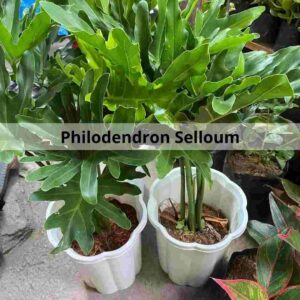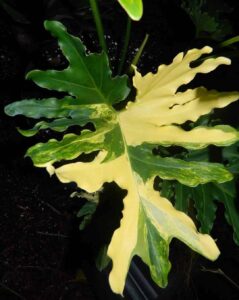Philodendron Selloum
Philodendron selloum or the lacy tree philodendron is a widely appreciated houseplant that attracts any and everybody in its vicinity with the help of its gorgeous and captivating leafy outlook. The strong and sturdy stems of the selloum hold beautifully patterned leaves to make an incredible addition to your botanical collection.

Despite the openness in its appearance, Philodendron Selloum is a gentle low-maintenance houseplant. As a proud plant parent, you’ll find joy in keeping these plants healthy when caring for them. The unique finger-like leaves of the plant are likely to be a favorite among new plant parents as well.
Botanical Classification
| Family | Araceae |
| Species | Solleum |
| Genus | Thaumatophyllum |
Unlike countless other Philodendron varieties, Phil Selloum even produces edible fruits that can be consumed after being cooked or used in compotes. The welcoming nature of Philodendron paired with its edibility and captivating vining nature makes for a well-rounded houseplant.
It can be a concern for some on the degree of toxicity of Philodendron Selloum. They contain a unique form of calcium oxalate crystal compound that can cause a problem with its toxicity while consuming them. However, that quandary does get resolved as you cook or dry out the Selloum as it breaks down the plant’s crystalline structure.
Also read:- Philodendron Deja Vu: Care & Propagation
Philodendron Selloum Variegated

One of the variety of this beautiful indoor plant amaze you with its variegated leaves that changes its colour over time. Selloum Giant Split Leaf Phil has dark green leaves variegated with light green that changes to yellow and finally into like white colour.
Philodendron Selloum Care
Philodendron Selloum is a warmth-loving plant that appreciates a humid environment with the availability of indirect yet bright sunlight. Obviously, it is necessary to take care of Selloum despite being quite a low-maintenance houseplant.
Proper pruning, fertilizing, watering, and propagating Philodendron Selloum are essential to keep them from dying or breaking down. So, let us dive in together on a few caring requirements for the Philodendron:
1. Adequate Sunlight
Similar to wide varieties of Philodendron, it is necessary for the Selloum that they get indirect yet bright sunlight. If you have a pot in your room, try keeping it near a window. However, ensure that the Philodendron leaves are kept relatively away from direct sunlight.
Long-term exposure to direct sunlight can burn your Philodendron’s foliage. This, in turn, can permanently damage the leaf on the Philodendron Selloum. Furthermore, regular exposure to excessive light can change the leaves into a pale yellow color.
However, despite the effect that extreme lighting can have, Philodendron Selloum must get adequate sunlight. Also, you should regularly rotate the Philodendron pot so that all the plant parts get enough light and don’t feel left out. Similarly, clean off the leaves if dust starts making the plant their living room. This helps expedite the photosynthesis process in them.
2. Use good quality soil.
As with most other houseplants, soil with well-draining capacity is essential for healthy growth. Similarly, Philodendron Selloums prefer alkaline soil with equal parts compost, coco peats, or orchid bark. Unlike other Philodendron plants, Selloum does not thrive well when they’re grown over salty or overly acidic soil.
3. Proper Soil Moisture
Plants need enough water to grow in a healthy manner. However, with Philodendron Selloum, as with any other plant, maintaining the proper moisture level in the soil is necessary.
There are many factors that determine the watering needs of your plants. The room in which the plant is kept can be a significant factor. Air conditioning and multiple windows that allow sunlight can cause the room to be dry. As a result, the soil gets dry more frequently and needs to be watered more.
The bathroom and kitchen tend to make up a humid and warm environment in slight contrast. As a result, the soil tends to stay moist for a longer time and needs less watering. For Philodendron Selloum, mildly soggy soil works best but do not wait until the soil is parched.
Try using distilled water and water once a week. Let the central root system of the Selloum absorb the water thoroughly. Obviously, do not overwater to not cause root rot in them. Pale yellow marks on the leaves can appear if you are underwater or overwatering Philodendron Selloum.
4. Using Fertilizers
Using fertilizers on the plant once a month can be enough for a healthy Selloum. It needs balanced FYM fertilizer in a diluted state. This helps make the plant well-nourished and well resistant to diseases.
Additionally, using too much fertilizer can turn the leaves brown.
5. Acceptable Temperature
Warm and humid conditions are best for Philodendron Selloum. They require humidity of 60 to 65 percent. As a South American native plant, a room temperature of around 77 F would be ideal. Also, keep your Selloum pot away from the Air conditioner or heating vents to maintain its temperature.
6. Pruning
Pruning is a critical practice to keep a plant healthy. It would be best if you pruned any dead or infected leaves of your Selloum. This helps prevent necessary nutrients from being wasted by the dead leaves.
Pruning, providing a suitable temperature, managing moist soil, proper use of fertilizers, and keeping your Philodendron Selloum healthy. In order to increase the number of plants in your home and keep it healthy, propagation is also an important aspect.
7. Potting and Repotting
Philodendron Selloum should be repotted when the size of the plants becomes significant for the older pot. This can usually be from 18 to 24 months. Using a two to four-inch pot more prominent than the previous one would be best for the plant.
Philodendron Selloum Propagation
If your plants look healthy with green lush foliage, have root-bound conditions, and have grown to 8 or 10 feet, it would be a good time to propagate Philodendron Selloum.
Philodendron Selloum can be propagated either by cutting stem or by cutting its roots. Similarly, it can be done either in water or in a soil mix as per the wish of the plant parent.
Steps required for proper propagation of Philodendron Selloum are mentioned as follows:
Managing tools: potting mix, ethanol, pruning/ propagating knife
Selection: Determine the cutting method. Cut a four to the six-inch-long stem above another leaf on a specific branch that you decide on.
For root cutting, select healthy young roots with no signs of decay or rot. Clean the root with water to verify its health of the root. Then, keep the root in collocation before beginning to propagate it.
Propagation in Soil Mix
- It will be easier for the stem or the root to propagate if the rooting hormone is applied to it.
- Fill a small container with orchid bark, perlite, and vermiculture soil mix.
- Immerse the bottom node of both the root and the stem while ensuring that the top leaves stay well above the soil level.
- Keep the soil on the pot moist by thoroughly watering it every two to three days for fresh propagation.
- In a few weeks, transfer the propagated plant to a larger pot with good soil mixed with peat moss, vermiculture, orchid bark, or coco coir.
Price
You can easily purchase Philodendron Selloum from a local nursery or order it online. Usually, a pot of this plant can cost $ (7-12).
Disease Control
Sometimes your plant can get pest infestation or disease. It may or may not be due to the lack of proper care for the plant. In selloum, it is common to see spots on their leaves if they get sick.
If you spot any problem with your Selloum pot, control the damage with these procedures:
- A certain part of the plant can get affected. If so, immediately prune the infected stem or the leaves. But keep in mind to properly sterilize the pruning tools before using them.
- Use a hydrogen peroxide mixture (2 parts water and 1 part Hydrogen peroxide) to treat root rot.
- Properly dispose of plants with medium to extreme root rot.
- Do not spray water on the leaves and get them unnecessarily wet. Slightly spraying can be acceptable.
- Water and hose off pests when possible
- Use neem oil or vinegar mix as an herbicide.
- In terms of potting mix, try purchasing aphid-free mix.
Is Philodendron Selloum poisonous?
Philodendron Selloum is not poisonous. However, its consumption in large quantities can cause some health problems. The toxins in this plant can cause drooling, diarrhea, tight throat/tongue, nausea, and vomiting when consumed in large quantities. Skin irritation can also be found in some that come in contact with the cell sap of the plant.
What is the ideal size for Philodendron Selloum?
This moderate grower tends to grow eight to ten feet tall with about six feet of width. This is under ideal growing conditions and with the availability of the proper growing environment.
Can I grow Philodendron Selloum outdoor?
Despite being used as a houseplant in the US and many other countries, Philodendron Selloum grows and thrives well in an outdoor environment.
Conclusion
Philodendron Selloum can be an excellent house plant for plant lovers when cared for properly. It is fairly easy to care for and propagate as well. Not to mention the joy it provides when you get to see the large green leaves of the Selloum grow more beautiful than you propagated and cared for.
They are relatively straightforward and fulfilling to care for, and you can see the benefits of doing so yourself. However, make sure you correctly follow the steps of caring for and propagating the plant. From the selection of the cutting process to caring and repotting, every step of the process is equally important.

